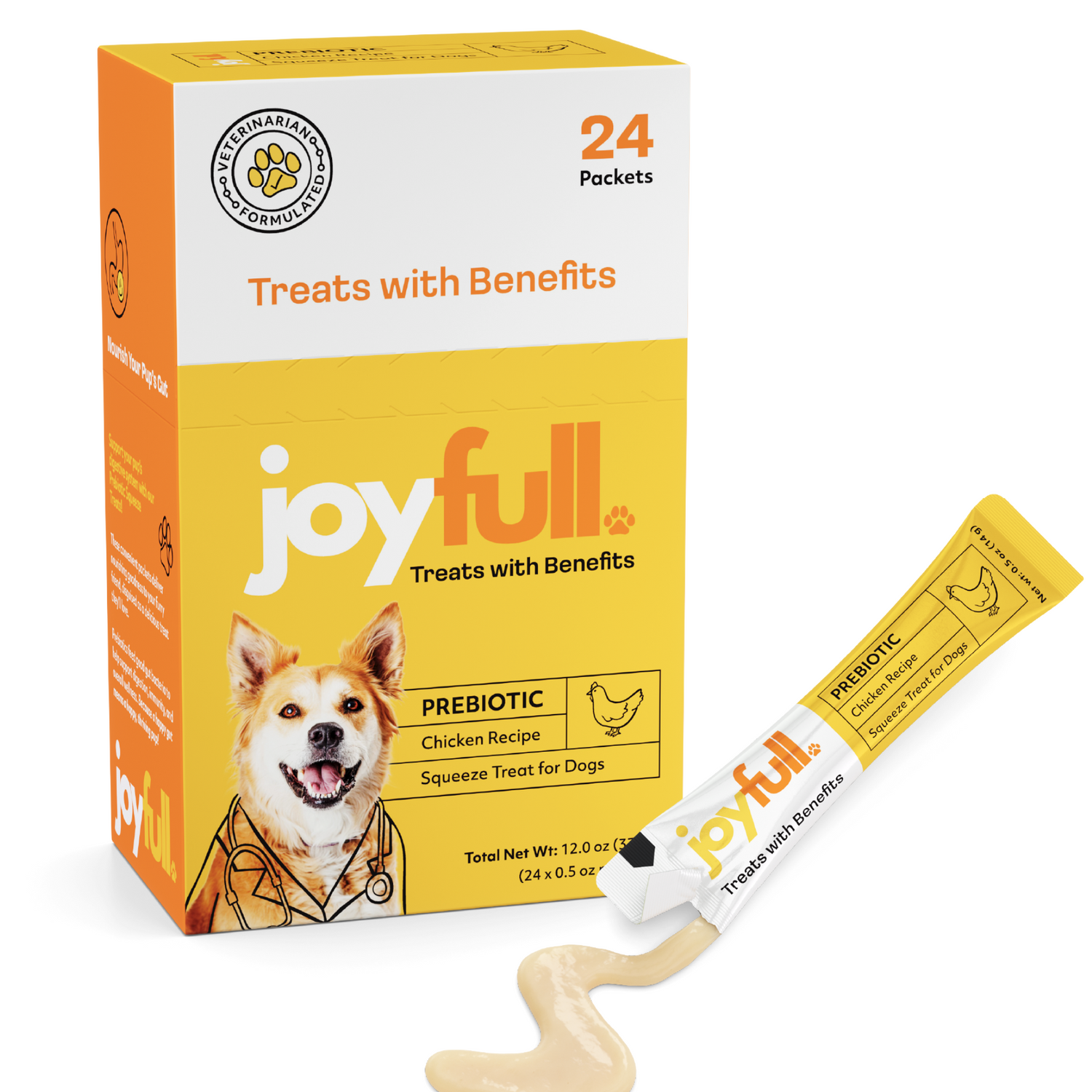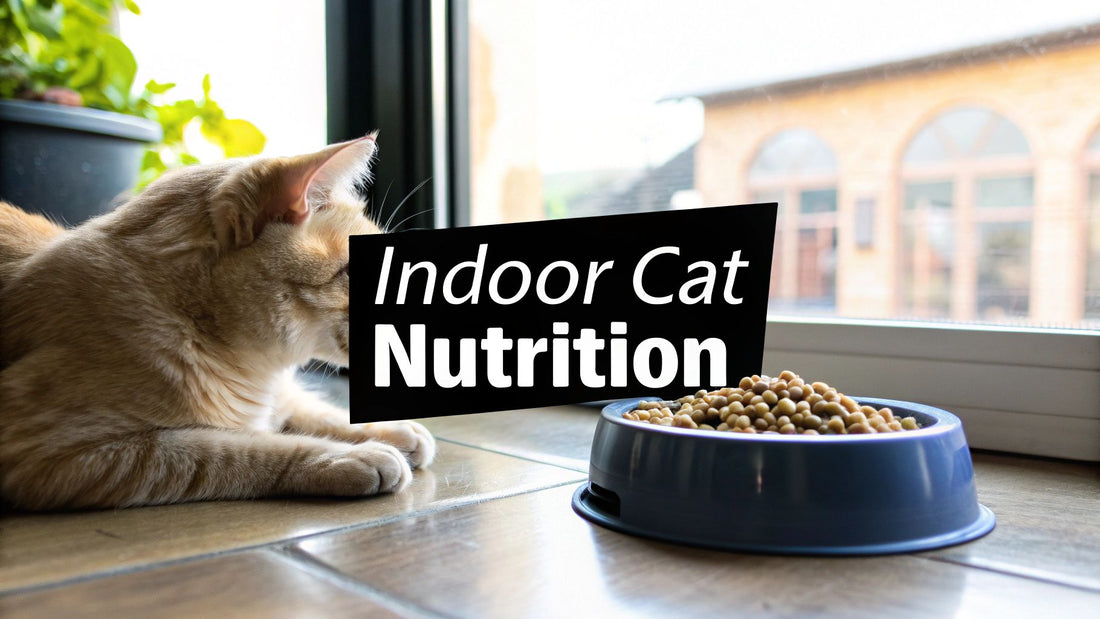
The Best Cat Food for Indoor Cats
When you're looking for the best cat food for indoor cats, you need a formula that’s low in calories but high in protein. It should be specifically built to manage weight, help with hairballs, and support urinary health. The best options will always list a real, named animal protein—like chicken or fish—as the very first ingredient and include functional fibers from sources like pumpkin.
Understanding Your Indoor Cat's Unique Needs
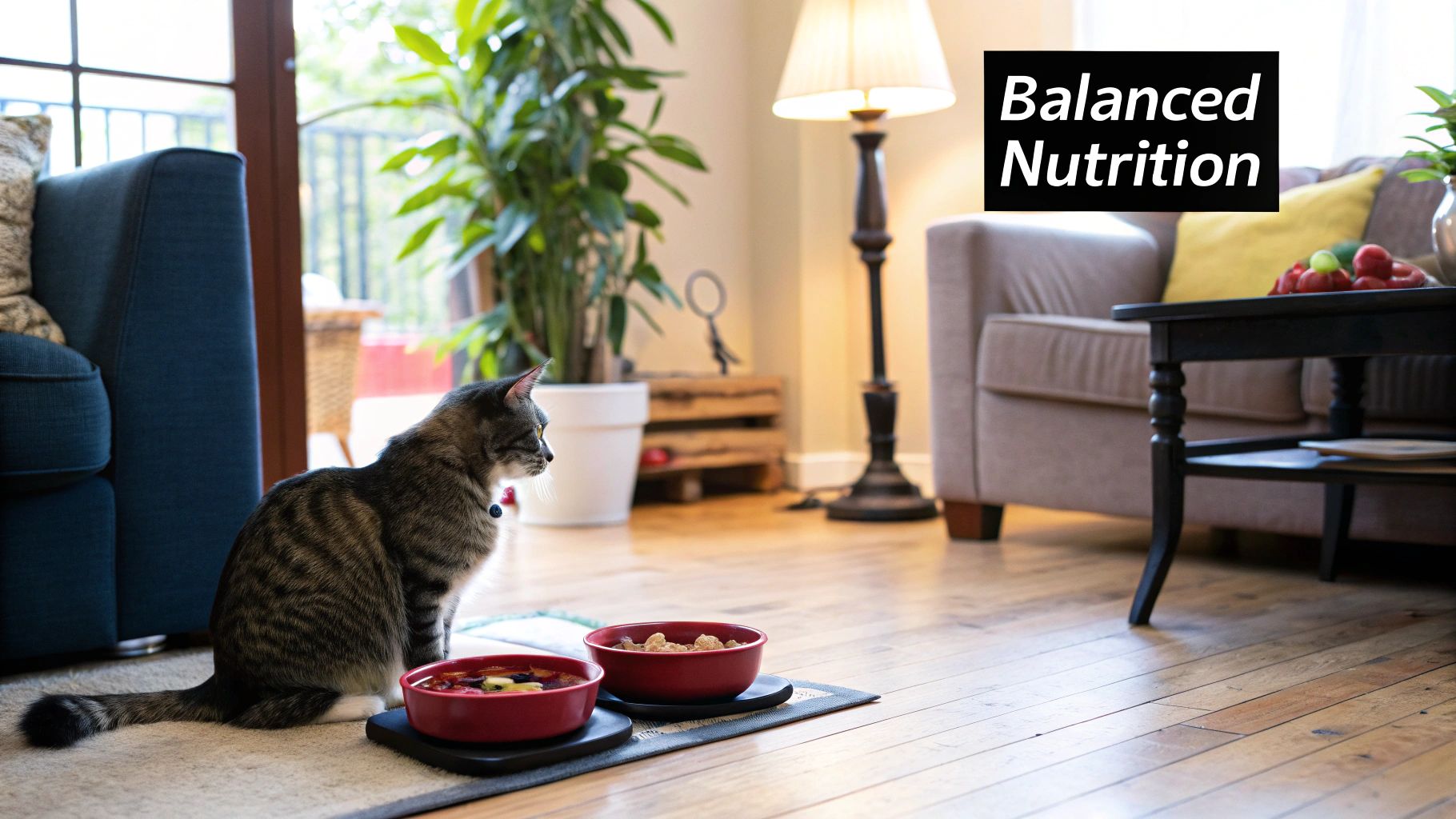
An indoor cat's life is a world away from that of a cat who roams outdoors. Think about it: an outdoor cat spends its days patrolling territory, climbing, and hunting. An indoor cat's biggest adventure might be a quick dash from the sofa to the food bowl.
This calmer, less active lifestyle creates a very specific set of nutritional needs that generic cat food often misses.
It’s a bit like comparing the dietary needs of a professional athlete to someone with a desk job. You wouldn't feed them the same meal plan, right? Giving your indoor cat a high-calorie food designed for a constantly moving outdoor explorer is a recipe for health problems down the road. The main challenge is finding the perfect balance between their energy intake and their much lower energy output.
Here’s a quick comparison showing why a specialized diet is so important for cats living exclusively indoors.
Indoor vs. Outdoor Cat Needs at a Glance
| Nutritional Factor | Indoor Cat Requirement | Outdoor Cat Requirement |
|---|---|---|
| Calorie Density | Lower to prevent weight gain | Higher to fuel an active lifestyle |
| Protein Levels | High to maintain lean muscle | High to support muscle repair and energy |
| Fiber Blend | Specialized for hairball control | Standard for digestive regularity |
| Urinary Support | Crucial due to lower water intake | Important, but less of a primary focus |
As you can see, while both need high-quality protein, the supporting cast of nutrients and the overall calorie count need to be quite different.
H3: Why Calorie Control Is Non-Negotiable
Because they simply don't move around as much, indoor cats are far more likely to become overweight. A well-designed indoor cat food takes this into account, delivering all the vital nutrients your cat needs but in a less calorie-dense formula. This approach helps them maintain a healthy, lean body without feeling constantly deprived.
Keeping your cat at a healthy weight isn't just about looks; it's absolutely vital for their long-term health. Extra pounds put a huge strain on a cat's joints, heart, and organs, which dramatically increases their risk for serious issues like arthritis and diabetes. The right diet is your first and best line of defense.
H3: Tackling Indoor-Specific Challenges
Beyond just weight management, the best cat food for indoor cats is formulated to address other common lifestyle-related issues. With less to do, indoor cats can spend up to two-thirds of their waking hours grooming themselves. This leads to an all-too-familiar problem: hairballs.
Specialized indoor formulas often contain a precise blend of fibers that help gently move ingested hair through the digestive tract. This simple addition can make a huge difference in reducing the formation of uncomfortable, and sometimes dangerous, hairballs.
But it doesn't stop there. A controlled environment and lower activity levels can also affect a cat's urinary health, making them more susceptible to problems. Proper nutrition helps manage mineral levels and promote a healthy urinary pH.
Of course, diet is the cornerstone of your cat's health, but it’s still just one piece of the puzzle. A holistic approach is always best. Beyond what's in their bowl, understanding overall cat health and the role of environment is key. Creating an enriching space with plenty of opportunities for play and mental stimulation is just as important as their nutrition. Choosing the right food is about supporting their entire well-being, from the inside out.
The Building Blocks of a Perfect Indoor Cat Diet
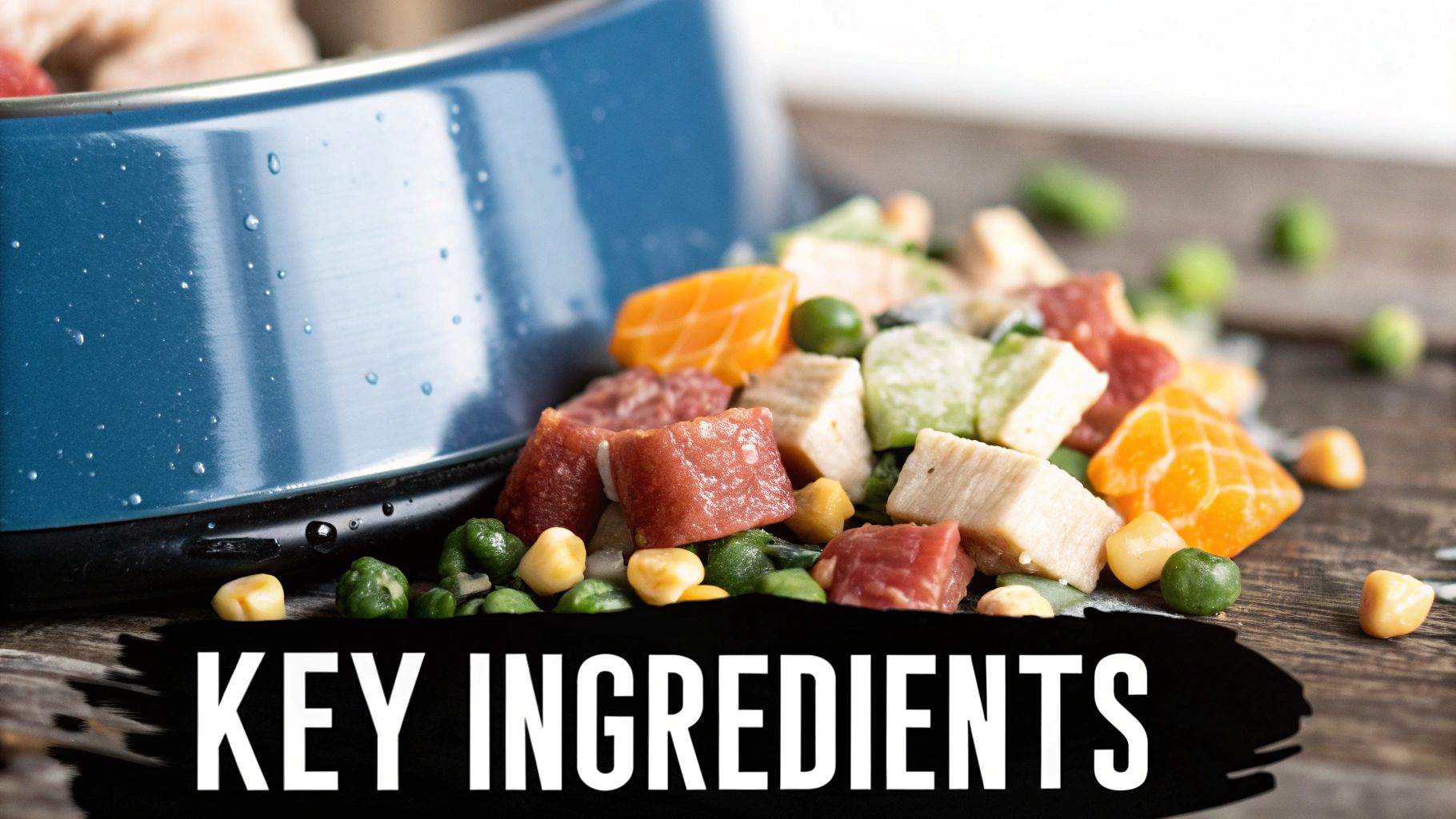
Think of choosing the right food for your indoor cat like building a custom home. You can't just use generic materials; you need a blueprint and high-quality components specifically designed for the job. For an indoor cat, that blueprint is all about fueling their health for a less active lifestyle, which means maximizing certain nutrients while carefully managing others to prevent weight gain.
The absolute foundation of that house—the non-negotiable cornerstone—is animal-based protein. Cats are what we call "obligate carnivores." In simple terms, their bodies are hardwired to run on meat. This isn't just a preference; it’s a biological necessity.
High-quality protein from real chicken, turkey, or fish delivers the essential amino acids they desperately need to maintain lean muscle. This is crucial for an indoor cat, as strong muscles help support their metabolism even when their biggest workout is a leap from the floor to the sofa.
The Power Players: Protein and Fat
When you turn over a bag of cat food, the very first ingredient should be a specific, named meat source. If you see vague terms like "meat by-products" or a generic "animal protein," consider it a red flag for a lower-quality formula.
Look for transparency on the label.
- Excellent Choices: Deboned Chicken, Turkey, Salmon, Lamb
- Less Ideal: Meat and Bone Meal, Animal By-Product Meal
- Avoid: Vague, unnamed "animal" sources
Fat is the next crucial piece of the puzzle. It’s a vital energy source, but for a cat who spends its days lounging, the amount has to be just right. Healthy fats, especially omega-3 and omega-6 fatty acids, are fantastic for supporting a healthy skin barrier and a shiny, soft coat. They also play a role in joint health and brain function.
The trick is balance. Too much fat means too many calories, which is a fast track to obesity for a housecat. The best cat food for indoor cats will contain just enough healthy fat from sources like chicken fat or salmon oil to deliver those benefits without packing on pounds.
Managing Carbs and Fiber the Right Way
This is where so many cat foods miss the mark. Biologically, cats have almost no need for carbohydrates. In the wild, the only carbs they’d eat would be from the stomach contents of their prey. High-carb formulas loaded with fillers like corn, wheat, and soy can easily lead to weight gain and digestive upset.
While it's nearly impossible to find a completely carb-free dry food, the source and quantity are what really matter. A small amount of easily digestible carbs from something like sweet potatoes or peas is a world away from cheap, starchy fillers.
For an indoor cat, fiber is a functional superstar, not just filler. A specific blend of soluble and insoluble fibers is key to managing two major indoor cat issues: hairballs and digestive regularity.
Think of the right fiber blend as a gentle broom for their digestive system. It sweeps ingested hair through the tract before it can turn into a nasty hairball. Ingredients like pumpkin and beet pulp are fantastic for this. They also help your cat feel full and satisfied, which is a huge plus for any weight management plan. Learning what's what on an ingredient list is half the battle; for a deeper look, check out our guide on how to choose cat food.
Essential Micronutrients for a Long, Healthy Life
Finally, a truly great indoor cat food is fortified with a specific suite of vitamins and minerals. These aren't just "nice-to-haves"—they are essential for your cat's long-term wellness.
At the top of that list is taurine, an amino acid found almost exclusively in animal tissue. Cats can't make enough of it on their own, so they absolutely must get it from their diet. A taurine deficiency is serious business, potentially leading to severe heart conditions and blindness.
Other critical additions to look for include:
- Antioxidants (like Vitamin E and Vitamin C): These are the body's little protectors, helping to support a robust immune system.
- Probiotics: Good gut bacteria that are key for healthy digestion and making sure your cat absorbs all the nutrients from their food.
- Controlled Minerals (Phosphorus and Magnesium): Keeping these minerals in careful balance is crucial for maintaining urinary tract health and preventing painful crystals or stones from forming.
When all these building blocks are in place, you’re not just feeding your cat—you’re providing a nutritional foundation for a long, happy, and vibrant life indoors.
How to Read Pet food Labels Like an Expert
Walking down the cat food aisle can be dizzying. Brightly colored bags and splashy marketing claims all scream for your attention. But the real secret to finding the best food isn't on the front of the bag—it's tucked away in the fine print on the back.
Learning how to decode a pet food label is probably the most important skill you can have when choosing the best cat food for indoor cats. Think of the label as the food's resume. The front is the flashy cover letter designed to catch your eye, but the ingredient list and the guaranteed analysis are where the real qualifications live. These two sections tell you everything you truly need to know.
Decoding the Ingredient List
Your first stop should always be the ingredient list. By law, ingredients have to be listed in descending order by their pre-cooking weight. This is a huge clue. It means the first few ingredients are what make up the bulk of the food, and that’s why they matter so much.
The goal here is simple: look for high-quality, named animal proteins right at the top.
- What You Want to See: Look for "Deboned Chicken," "Salmon," "Turkey," or "Lamb" as the first one or two ingredients. These are the protein powerhouses that will support your cat's lean muscle mass.
- What to Be Wary Of: Vague terms like "meat by-products" or "animal digest" should give you pause. While not all by-products are inherently bad, a named source like "chicken liver" is always a clearer sign of quality and transparency.
- The Fillers to Avoid: Things like corn, wheat gluten, and soy often pop up high on the list in lower-quality foods. These are essentially cheap fillers that add carbs but offer little nutritional value for a true carnivore, often contributing to unwanted weight gain.
The global pet food market is massive, projected to hit around USD 132.4 billion by 2025. While standard pet foods still dominate the shelves, there's a growing wave of pet owners demanding premium, specialized diets for their indoor cats as they become more savvy about nutrition. You can discover more insights about these pet food market trends to see just how much this space is changing.
Translating the Guaranteed Analysis
Right next to the ingredients, you'll find a box called the "Guaranteed Analysis." It looks a lot like a human nutrition label but focuses on the minimum or maximum percentages of four key nutrients: crude protein, crude fat, crude fiber, and moisture.
Key Insight: Don't let the word "crude" throw you off. It simply refers to the scientific method used for measurement; it has nothing to do with the quality of the nutrient itself. Understanding these numbers is vital for matching a food to your indoor cat's more sedentary lifestyle.
Here’s a quick guide to the numbers that matter for an indoor cat formula:
- Crude Protein (Minimum %): This is the big one. For an indoor cat, you want to see a high minimum protein level—ideally 30% or more on a dry matter basis—to help maintain their muscle tone without a lot of activity.
- Crude Fat (Minimum %): Fat is a crucial source of energy, but it's easy to overdo it. A moderate fat level, somewhere in the 12% to 18% range, is perfect for most indoor cats.
- Crude Fiber (Maximum %): Fiber is your friend when it comes to digestive health and hairball control. A higher fiber content, often between 4% and 8%, helps your cat feel full and keeps things moving smoothly.
- Moisture (Maximum %): This just tells you how much water is in the food. For dry kibble, this will be low (around 10%), whereas wet food can be 75% water or even higher.
This infographic breaks down how these different nutritional priorities—high protein, balanced fiber, and adequate moisture—all work together to support a healthy indoor cat.
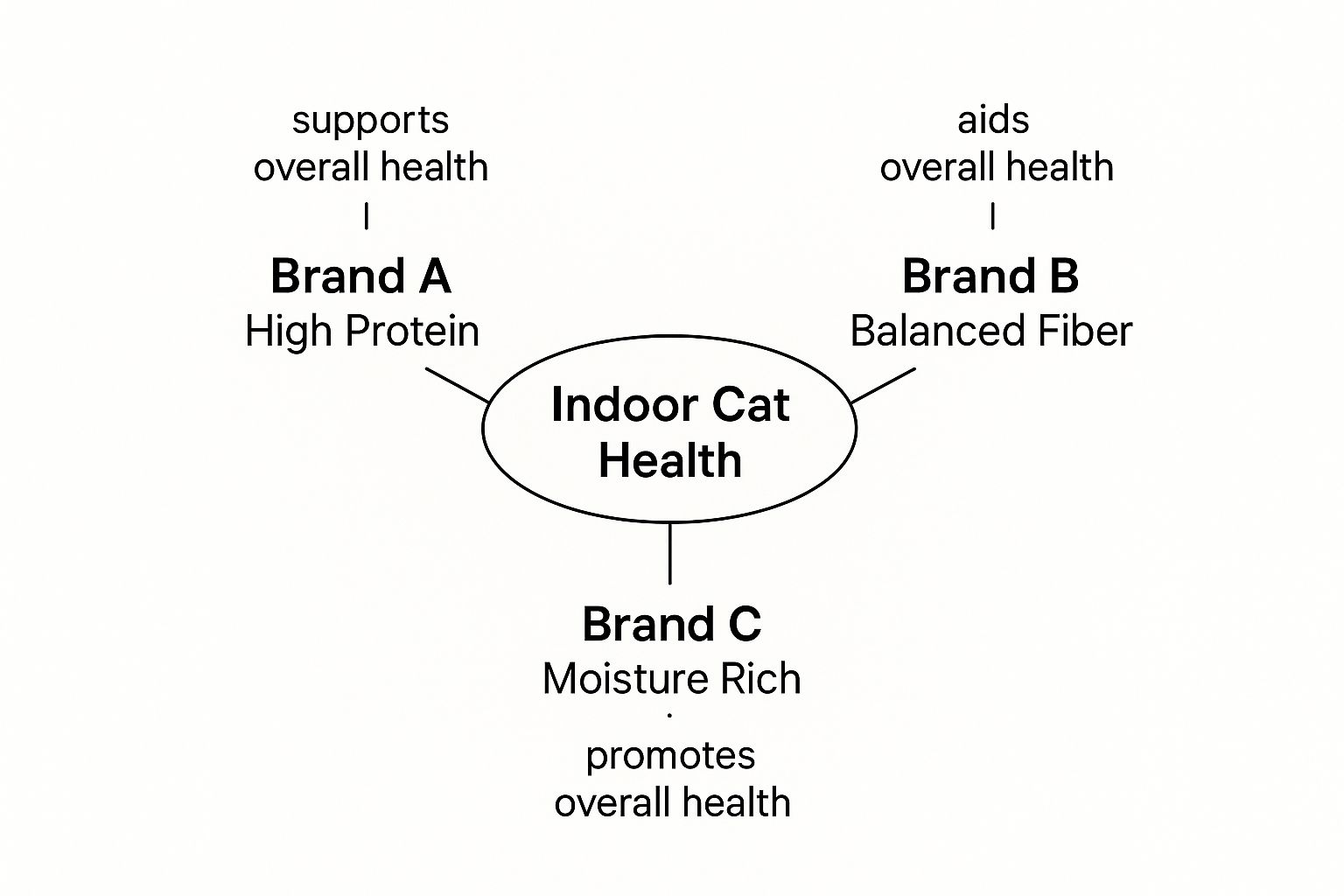
As you can see, there isn't one single "perfect" formula. It's about finding the right combination of these key elements that supports a healthy, happy life indoors. Once you get the hang of reading these two parts of the label, you'll be able to see right past the marketing fluff and make a confident choice based on solid nutritional facts.
Wet Food vs. Dry Food: Settling the Great Debate
Walk down any pet food aisle, and you’ll be faced with the classic dilemma: wet food or dry kibble? It’s one of the biggest decisions a cat owner makes, and everyone seems to have a strong opinion. The honest answer? There’s no single right choice for every cat. The best food really depends on your cat’s specific health needs, your lifestyle, and even your budget.
Let's break down what really matters.
The Critical Role of Hydration
If there's one knockout argument for wet food, it comes down to a single word: hydration. This is a big deal for cats. Their ancestors were desert hunters who got almost all the water they needed directly from their prey. Because of this, our modern house cats have a naturally low thirst drive. They just don't feel the urge to drink enough from a water bowl, which can lead to chronic, low-level dehydration. Over time, this puts a serious strain on their kidneys and urinary tract.
This is where wet food shines. A good quality wet food is typically made up of 75% or more moisture. Every bite is a source of hydration, closely mimicking what they'd get in the wild. This constant moisture intake helps flush their system, making it much harder for painful urinary crystals to form. It’s for this very reason that so many vets advocate for at least some wet food in an indoor cat’s diet.
The Convenience of Kibble
Now, let's talk about dry food. There's a reason kibble is so popular—it's incredibly convenient and often easier on the wallet. The global demand speaks for itself; dry food dominates the market because it fits so well into our busy lives. If you’re curious, you can see just how significant this trend is in the cat food market on a global scale.
So, what are the big draws for kibble?
- Ease of Use: You can leave a bowl of kibble out for your cat to graze on throughout the day without worrying about it spoiling. This "free feeding" style works well for many cats and their owners.
- Budget-Friendly: When you compare them ounce for ounce, even premium dry foods are usually more affordable than their wet counterparts.
- Dental Benefits: Some kibble is specifically designed with a crunchy, abrasive texture that can help scrape plaque off your cat's teeth as they chew.
The main downside, however, remains its lack of moisture. When you're trying to find the best cat food for indoor cats, this is a major factor to consider.
Comparing Wet and Dry Food for Indoor Cats
To make the choice clearer, it helps to see the pros and cons side-by-side. Every cat is an individual, so what works for one might not be ideal for another. This table breaks down the key differences to help you weigh your options.
| Feature | Wet Cat Food | Dry Cat Food (Kibble) |
|---|---|---|
| Moisture Content | High (75%+): Excellent for hydration, supports kidney and urinary health. | Low (around 10%): Cats must drink more water to stay hydrated. |
| Protein & Fat | Often higher in animal-based protein and fat, lower in carbohydrates. | Can be higher in carbohydrates and plant proteins, depending on the formula. |
| Palatability | Strong aroma and soft texture are highly appealing, especially for picky eaters. | Crunchy texture is satisfying for some cats, but less appealing to others. |
| Convenience | Must be served in meals and refrigerated after opening; spoils quickly. | Can be left out for "free feeding" and has a long shelf life. |
| Cost | Generally more expensive per calorie. | More budget-friendly, especially when buying in bulk. |
| Dental Health | Provides no abrasive action to clean teeth. | Some formulas can help reduce plaque and tartar buildup. |
Ultimately, the best choice often comes down to balancing these factors based on your cat's specific health profile, age, and even their personal preferences.
The Best of Both Worlds: Mixed Feeding
What if you don’t want to choose? Good news: you don't have to. For many cat owners, the perfect solution is mixed feeding—using a combination of both wet and dry food.
Mixed feeding is a flexible and effective approach that combines the hydration benefits of wet food with the dental and cost advantages of dry kibble, creating a balanced and appealing diet for many indoor cats.
This approach gives you the hydration of wet food with the convenience and dental benefits of kibble. It's a win-win.
Here are a couple of popular ways to do it:
- Serve Separate Meals: Offer a portion of wet food once or twice a day (say, for breakfast and dinner) and leave a measured amount of kibble out for them to graze on in between.
- Use as a Topper: Mix a spoonful of wet food into their dry kibble. This adds a burst of flavor and a much-needed moisture boost, which can be fantastic for enticing picky eaters.
By combining the two, you can craft a feeding routine that keeps your cat healthy and happy while fitting perfectly into your own daily life.
Common Cat Food Myths Debunked
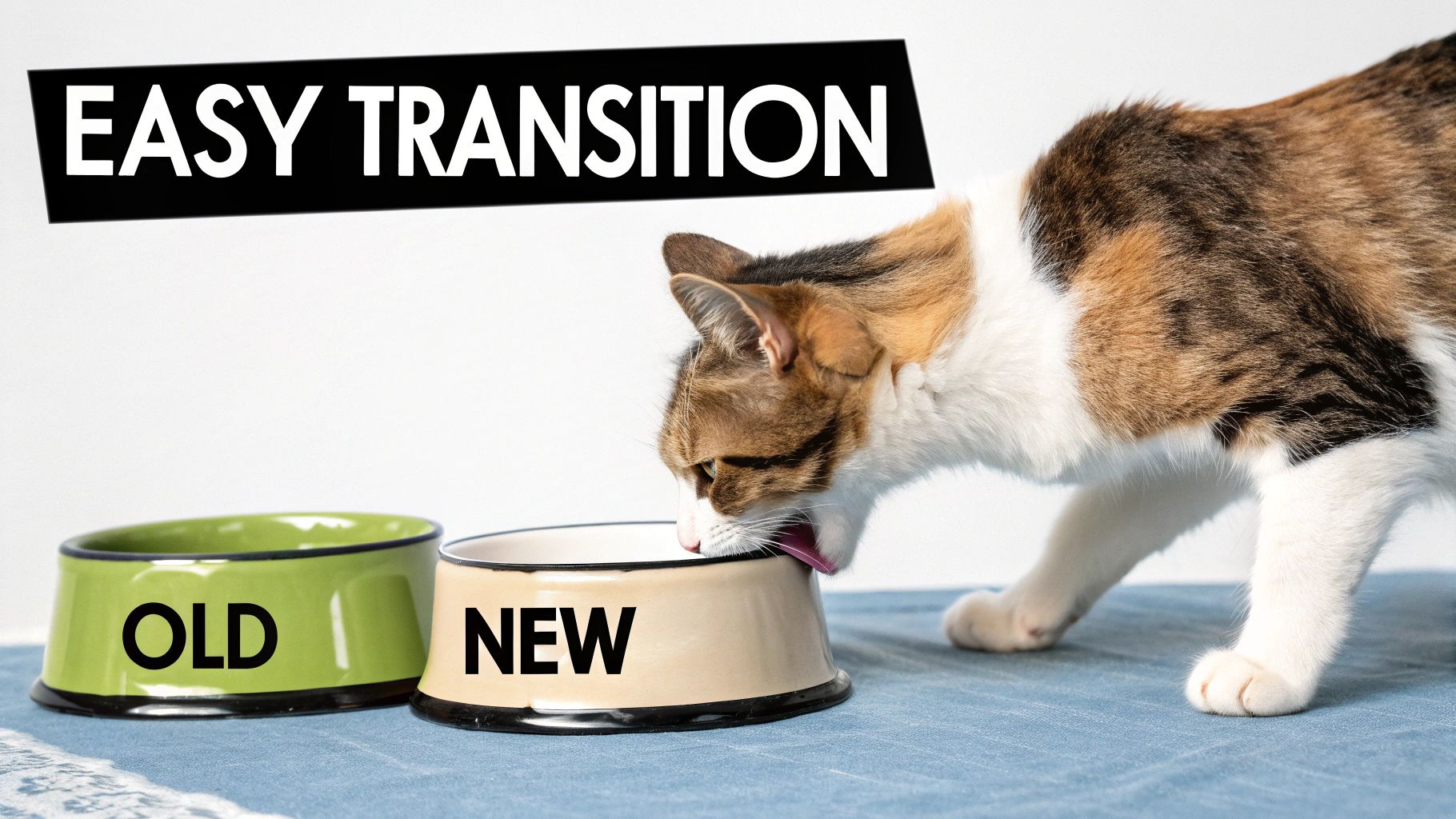
If you've ever gone online for cat food advice, you know it's a jungle out there. The internet is flooded with strong opinions and "hot takes" that make it incredibly hard to tell what's real and what's just noise.
So, let's cut through the confusion and tackle a few of the most persistent myths head-on. Getting these right is a huge step toward choosing the best cat food for indoor cats—one based on science, not fads.
Myth 1: All Grains Are Bad for Cats
This one is everywhere. The story goes that grains are just cheap fillers that have no place in a cat's diet. But that's a massive oversimplification. The real issue isn't grains, it's the quality and quantity of those grains.
Sure, a cat's diet must be built around animal protein. But a small amount of a high-quality whole grain, like brown rice or barley, can be a great source of fiber and energy. The problem arises when a food is packed with low-grade fillers like corn or wheat gluten at the top of the ingredient list. A little wholesome grain further down? That's perfectly fine for most cats. If you want to dive deeper, we have a whole guide on cat food ingredients to avoid.
Myth 2: Cats Need a Constantly Changing Diet
We enjoy trying new foods, so it feels right to offer our cats the same variety. But here’s the thing: a cat's digestive system is a creature of habit. It’s a finely tuned machine that actually thrives on consistency.
Chopping and changing their food all the time can easily lead to an upset stomach, vomiting, or diarrhea. Think of their gut as a delicate ecosystem; sudden changes throw everything off balance. Once you find a high-quality food that your cat does well on, the best thing you can do is stick with it.
This doesn't mean a food change is off the table forever. It just needs to be done slowly and for a good reason, like a change in life stage. A proper transition should take at least 7-10 days to give their system time to adapt.
Myth 3: Raw Food Is Always the Best Choice
The raw food debate is passionate, to say the least. Supporters argue it’s more "natural" and can lead to benefits like a shinier coat. While a well-formulated raw diet is possible, it carries some serious risks that every cat owner needs to understand.
The two biggest red flags are bacterial contamination and nutritional gaps.
- Bacteria Risk: Raw meat is a potential carrier for nasty bacteria like Salmonella and E. coli. This isn't just a risk for your cat; it's a health hazard for every human in the house, too.
- Nutritional Gaps: Crafting a perfectly balanced raw diet at home is incredibly difficult. It’s dangerously easy to miss out on essential nutrients like taurine, which can lead to severe, long-term health problems.
It's no surprise that pet owners are looking for premium, specialized options. The global pet food market is projected to hit USD 186.1 billion by 2028, a massive jump from USD 88.9 billion in 2018. This growth is largely fueled by the demand for scientifically formulated foods for our indoor pets.
By choosing a trusted, cooked food like JoyFull, you get all the benefits of a high-protein, nutrient-dense diet without any of the risks that come with handling and feeding raw meat.
Switching Your Cat to a New Food the Right Way
So, you've found a fantastic new food for your cat. Awesome! But hold on a second before you dump it straight into their bowl. Cats are creatures of habit, and their digestive systems can be surprisingly sensitive. A sudden switch is often a recipe for an upset stomach or, worse, a full-blown food strike.
Think of it like this: you wouldn't jump straight from the couch to running a marathon. You’d ease into it. The same goes for your cat's diet. A gradual transition is the secret to making the move to a healthier food a positive, stress-free experience for everyone involved.
The whole point is to give your cat’s gut flora time to adjust. We've found that a slow and steady approach over 7 to 10 days is the gold standard. It helps prevent any digestive hiccups and gives them time to get used to the new flavors and textures.
The 7-Day Transition Plan
This simple mixing schedule is a tried-and-true method that almost always works. For the first couple of days, the new food is really just a little "garnish" on their old stuff. This lets your cat get familiar with the smell and taste without it being a big deal. As the week goes on, you’ll slowly tip the scales until they're happily chowing down on 100% of their new, better food.
Here’s a day-by-day guide to follow:
- Days 1-2: 75% Old Food + 25% New Food
- Days 3-4: 50% Old Food + 50% New Food
- Days 5-6: 25% Old Food + 75% New Food
- Day 7: 100% New Food
Now, remember this is just a guideline. You know your cat best. If you're dealing with a particularly picky or sensitive kitty, don't hesitate to stretch each stage out for an extra day or two. The most important thing here is to move at your cat's pace, not yours.
Tips for Winning Over a Picky Eater
Let's be real—some cats are just more skeptical of change than others. If your furry connoisseur is turning their nose up at the new mix, don't panic. There are a few tricks we've learned over the years to make that new food a lot more appealing.
My favorite trick? Gently warming up wet food. Just a few seconds in a microwave-safe dish can make a world of difference. It releases the aroma and makes it smell so much more enticing to a cat on the fence.
You can also try a few of these simple strategies:
- Bring on the Toppers: Mix in a tiny bit of something you know they can't resist. A splash of tuna juice (the kind in water, no salt added!) or a dollop of a lickable treat can be just the thing to spark their interest.
- Try Hand-Feeding: Offer a small bite of the new food from your hand. That personal touch can help build a positive association and show them it's safe and tasty.
- Create a Calm Dining Experience: Make sure mealtime happens in a quiet, low-stress spot. If they feel safe and aren't being bothered by other pets or loud noises, they're more likely to give something new a try.
As you go through this process, just keep an eye on your cat’s appetite, energy, and what's happening in the litter box. A little hesitation is perfectly normal. But if your cat stops eating for more than a day or shows any signs of an upset stomach, slow the transition way down. If you're concerned, a quick call to your vet is always a good idea. Getting this transition right sets the stage for a long and healthy life on their new, top-notch diet.
Your Top Questions About Indoor Cat Food Answered
Stepping into the world of cat food can feel overwhelming, and it's natural to have a few questions. Getting the right answers is the first step to choosing a food that helps your indoor cat thrive. Let's clear up some of the most common things cat parents ask.
How Many Calories Does My Indoor Cat Need?
This is probably the number one question on every cat owner's mind. As a solid starting point, most indoor adult cats need about 20-25 calories per pound of their ideal body weight each day. This helps them maintain a healthy, lean physique without packing on extra pounds from a sedentary lifestyle.
But remember, that’s just an estimate. A younger, more playful cat might need a bit more, while a senior cat who prefers napping will need less. Always check the feeding guide on your cat's food bag first, then watch their body condition. You can adjust the amount up or down from there.
Key Takeaway: Calorie counting for cats isn't an exact science. Pay attention to your cat's weight and shape. If you're ever unsure, your vet can give you a personalized recommendation that's perfect for your furry friend.
Are Grain-Free Diets Really Better for Indoor Cats?
"Grain-free" has become a huge marketing buzzword, but it doesn't automatically mean the food is better. The most important thing to look for in food for an indoor cat is a high level of quality, animal-based protein. Some "grain-free" formulas simply swap out grains for other starchy fillers like potatoes or peas, which can still lead to weight gain.
The truth is, while a small number of cats have true grain sensitivities, most have no problem digesting high-quality whole grains. Instead of focusing on what's not in the food, focus on what is—make sure real meat is the star ingredient.
How Can I Tell if My Cat Has a Food Allergy?
It's stressful to think your cat might be having an allergic reaction to their food. Interestingly, the most common signs aren't always tummy troubles; they often show up on the skin.
Keep an eye out for these common symptoms:
- Non-stop Itching: Is your cat constantly scratching, especially around their head, neck, or ears?
- Over-grooming: You might notice bald spots or irritated "hot spots" from excessive licking.
- Digestive Issues: Chronic vomiting or diarrhea can definitely be a red flag.
What surprises many people is that the most common food allergens for cats are proteins—like chicken, beef, or fish—not grains. If you think something is wrong, your veterinarian is your best partner. To get a better idea of what to look for, you can learn more about the specific signs of food allergies in cats. Figuring out the real culprit takes a careful approach, and a vet's guidance is the safest way to do it.
Ready to give your indoor cat the high-protein, balanced nutrition they were born to eat? JoyFull formulas are made with clean, purposeful ingredients, all backed by science to help your cat live a happy, healthy life inside.
